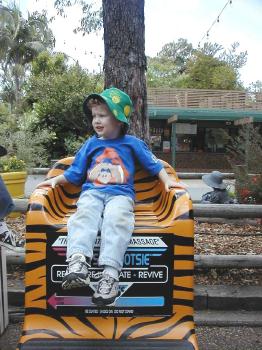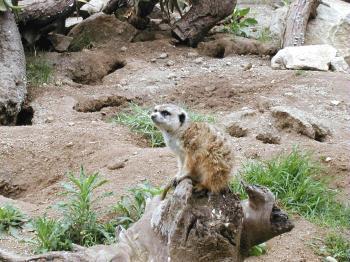San Diego, California (2005)

If you’ve been reading these travel pages you know our little guy loves animals. Naturally in San Diego we had to go to the famous San Diego Zoo and its affiliated Safari Park. The zoo was great (map), but the Safari Park had smaller crowds and more open space so that worked better for us. We would recommend either one, though. They’re both wonderful in their own ways.
The Safari Park is further away from San Diego than we expected, about 35 miles north of the city near the town of Escondido (map). The reason for the distance became obvious once we arrived. This facility had to be far enough away from the city to find sufficient land for animals to roam freely.
The Savanna

While there were plenty of walkable exhibits at the Safari Park, one truly impressive way to experience the wide open spaces was by taking a tour trolley through the winding paths of the back-country. This included a a simulation of an African savanna where plains animals roamed freely in a natural setting. Cape Buffalo relaxed in a valley nestled between two mountains defining the boundaries of the Safari Park. We came face-to-face with many large plains animals as we slowly rode through the park’s open acres.
Wildebeest

We also came upon a herd of wildebeests during our scenic trolley tour. In Africa a million of these magnificent beasts would form a constantly moving herd in search of grasslands, in one of the most amazing migrations on the planet. Here at the Safari Park, the wildebeests formed a much smaller herd but they had an easier life and a consistent source of food. The path behind the exhibit rose high enough above the valley floor to see far into Southern California’s coastal mountain range in the distance.
Meanwhile in San Diego

The next day we wandered over to the San Diego Zoo at Balboa Park near downtown San Diego. As always seems to be the case here, the weather was perfect. Our little guy rested on this large chair painted in tiger stripes. It was actually a massage machine but he didn’t know it and he didn’t particularly care. He just thought it was a really nice place to relax after spending a full day walking through the zoo, exploring the lairs of all those exotic animals. Notice that he convinced mom and dad to buy him a San Diego Zoo T-shirt with an orangutan on it.
Meerkat

The meerkat was one of our favorite animals to visit. They’ve received lots of attention and popularity at times through television shows such as Meerkat Manor. It’s a small mammal related to the mongoose and it lives in the deserts of Southern Africa in sociable family groupings called mobs.
This cute little fellow seemed quite friendly as he happily posed for photographs. In the wild these amiable creatures would survive mainly on a diet of insects that they forage while one of their members stands guard. Maybe that’s what our frisky little fellow was actually doing, although there wasn’t much to guard against in captivity in San Diego.
Gharial

The San Diego Zoo also had some more unusual creatures such as these gharials. They are a variant of crocodilians but are a distinctly different subfamily than either crocodiles and alligators. They are native to rivers of the northern Indian subcontinent. Gharials live mainly on fish which they catch in their ideally-shaped snouts. That large, bulbous object at the end of the snout is called a Ghara and is it is found only on the male of the species. While they look ferocious they are not particularly dangerous to humans, and are considered an endangered species.

Leave a Reply